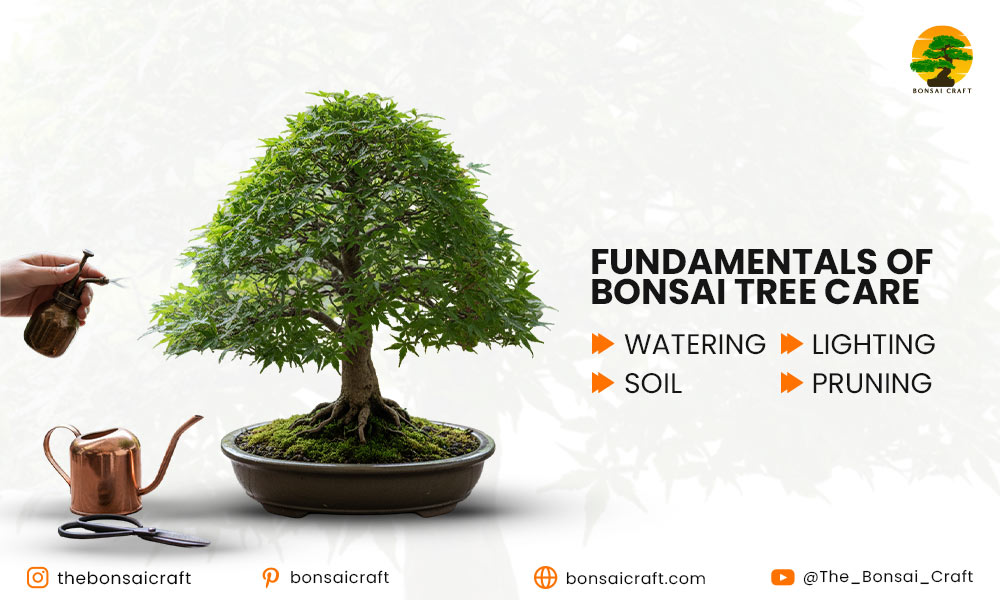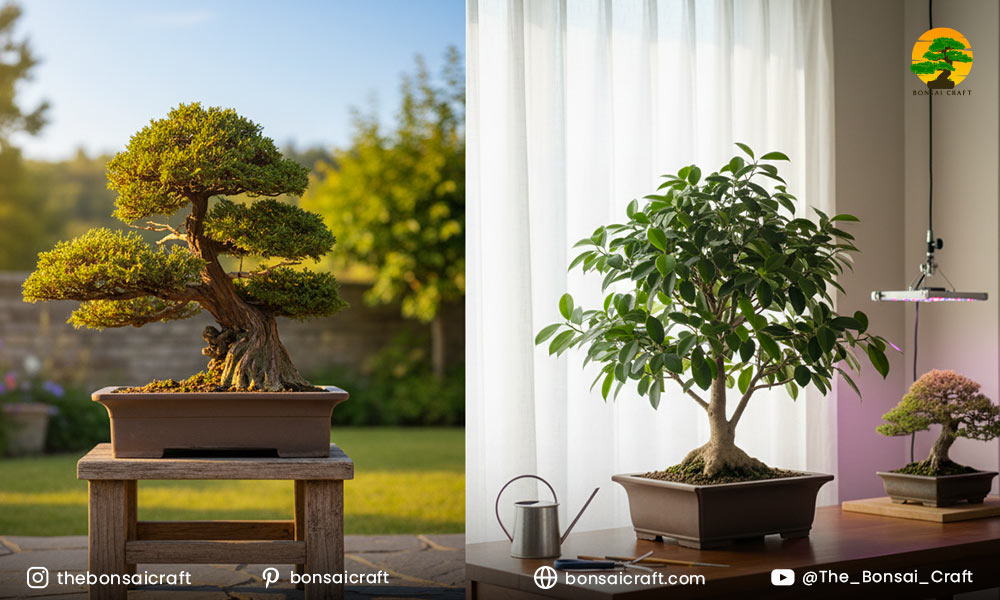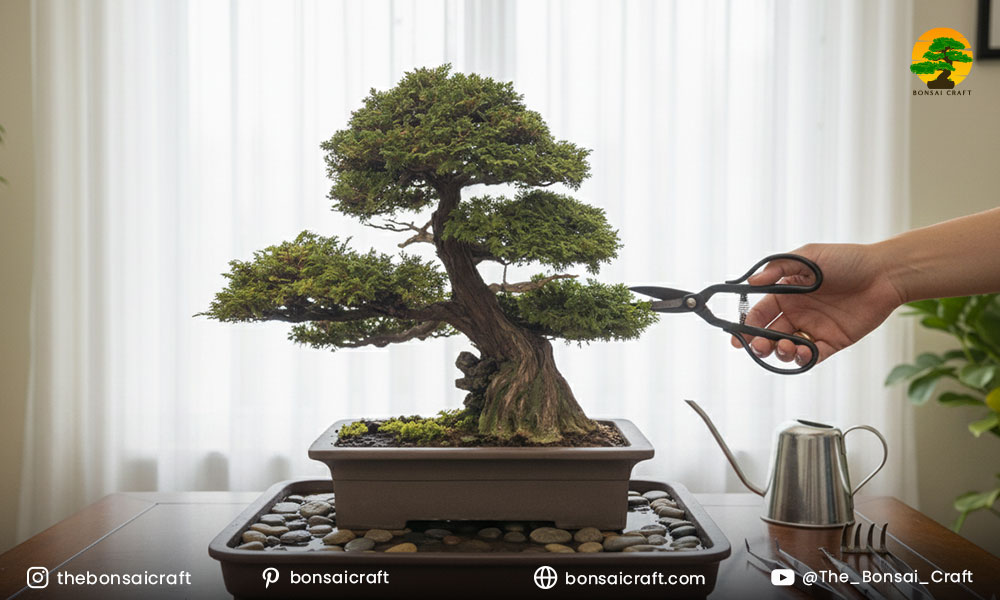
Bonsai trees are much more than miniature trees; they are a living piece of art that requires careful nurturing and attention. Whether you’re a seasoned bonsai enthusiast or a beginner, proper bonsai tree care is essential for keeping your tree healthy and thriving. If you’re wondering how to take care of a bonsai tree or looking for specific tips on bonsai care indoors, this comprehensive guide will provide you with expert knowledge and practical advice to help you maintain your bonsai tree in top condition.
What is Bonsai Tree Care?
Bonsai tree care involves specialized techniques like watering, pruning, wiring, fertilizing, and repotting to maintain miniature trees in a healthy, balanced form. Unlike regular plants, bonsai require careful monitoring of soil, light, and humidity to thrive.
Caring for a bonsai tree can be an incredibly rewarding experience, but it also comes with its challenges. From choosing the right species to understanding the needs of your tree, bonsai care requires a deep understanding of the plant’s requirements. Many beginners ask questions like “Are bonsai trees hard to take care of?” or “How to care for a bonsai tree indoors?” Fortunately, with the right care and commitment, anyone can grow and nurture a bonsai tree successfully.
As an expert in bonsai plant care, I’ve seen countless people struggle with maintaining their bonsai trees, whether it’s due to incorrect watering, insufficient light, or improper pruning techniques. This guide will not only answer your most common questions but will also share insights from my years of experience to help you care for bonsai trees in a way that ensures long-term health and growth.

The Fundamentals of Bonsai Tree Care
Proper bonsai care can be broken down into four main areas: watering, lighting, soil, and pruning. Understanding each of these is crucial to maintaining a healthy bonsai.
How to Water a Bonsai Tree
Watering is one of the most critical aspects of bonsai tree care. Improper watering can lead to either root rot or dehydration, both of which can harm your tree.
How to Care for a Bonsai Tree with Water:
- Watering Frequency: The soil surface and the moist layer of the soil have to sit at the same level. This surface has to be dry to the touch. This will depend on the species, pot, and climate. More of these trees have to be staged once every two to three days while in the growing season.
- Thorough Watering: Whenever you water, water with care. The pot should have water coming out the bottom, which means you are giving the roots enough moisture to slake their thirst. Shallow watering, which leaves the surface soil dry and cracked, should not be practiced.
- Avoid Overwatering: The moisture should not be so abundant that the pot feels heavy and the soil waterlogged. It’s crucial to get the balance right.

The Importance of Proper Light for Your Bonsai Tree
Light is another key component of bonsai tree care, as it directly affects photosynthesis and overall growth. Bonsai trees need plenty of light to thrive, though the amount of light varies by species.
How to Care for a Bonsai Tree with Light:
- Outdoor Bonsai Trees: Outdoor bonsai trees, particularly juniper bonsai trees, thrive best with 4 to 6 hours of direct sunlight every day. Make sure to place the tree in a position that will get a lot of bright sunlight.
- Indoor Bonsai Trees: Indoor bonsai trees, such as ficus bonsai, jade bonsai, and others, do best in bright indirect light. A better position is a south-facing window, which will ensure the bonsai is well illuminated.
- Artificial Lighting: If you lack sufficient natural light indoors, you can use grow lights to provide the necessary light for your tree. Use full-spectrum LED or fluorescent grow lights for 10–12 hours a day.
Choosing the Right Soil for Your Bonsai Tree
The soil used for bonsai tree care plays an essential role in ensuring healthy growth. Bonsai trees require well-draining soil that holds nutrients but allows water to flow freely, preventing waterlogging.
How to Choose Soil for Your Bonsai Tree:
- Bonsai Soil Mix: A bonsai soil mix is ideal soil for a bonsai tree. A mix that uses akadama, pumice, and lava rock will retain soil moisture and properly drain excess water.
- Repotting: Bonsai trees thrive when they are repotted every one to two years. This gives the roots ample space to grow. Refreshing the soil also stops the tree from becoming root-bound.
- Soil Quality: Look for bonsai soil that is high in quality, not standard garden soil. Roots will suffocate in ordinary soil because it does not drain properly.
Pruning and Shaping Your Bonsai Tree
Pruning is one of the most enjoyable and rewarding aspects of bonsai care. Proper pruning allows you to shape your tree, promoting healthy growth and keeping it in proportion.
How to Prune and Shape a Bonsai Tree:
- Pruning Tools: Bonsai pruning tools are very crucial. You should buy concave cutters and quality scissors to make the best bonsai.
- Pinch and Cut: Pinching back new growth so new branches can form helps to make your tree have a fuller appearance. Once a blossom has drooped, trim it back to improve the tree’s appearance and also improve tree health.
- Shaping: A bonsai’s shape is the result of careful pruning, direction leading growth, and wiring to lightly coax branches.
Caring for Specific Types of Bonsai Trees
Each species of bonsai tree has slightly different care requirements. Here, we’ll focus on two popular species: ficus bonsai and juniper bonsai.
H3: Ficus Bonsai Care
The ficus bonsai is an excellent choice for beginners due to its forgiving nature. It can tolerate a wide range of environmental conditions, making it easy to grow indoors.
How to Care for a Ficus Bonsai Tree:
- Watering: Ficus trees prefer to be kept moist, but not soggy. Water when the top layer of soil is dry.
- Light: Place your ficus bonsai near a bright, indirect light source. It can tolerate lower light conditions compared to other species, but it thrives with more light.
- Humidity: Ficus trees prefer a humid environment, so consider placing your tree on a humidity tray or lightly misting the leaves.
- Pruning: Prune regularly to maintain shape. Ficus trees are robust and can handle regular trimming.
Juniper Bonsai Care
The juniper bonsai is a hardy tree that does best in outdoor environments. It requires a bit more attention to sunlight and temperature.
How to Care for a Juniper Bonsai Tree:
- Watering: Junipers need to dry out slightly between waterings. Check the soil before watering, and only water when the top of the soil is dry.
- Sunlight: Junipers need full sunlight for at least 4–6 hours per day. If you keep it indoors, ensure it gets ample light from a south-facing window or artificial grow lights.
- Pruning: Junipers respond well to pruning. Trim the branches to maintain shape and remove any dead or unnecessary growth.

Indoor Bonsai Tree Care Tips
If you’re looking for advice on how to care for a bonsai tree indoors, there are a few things to keep in mind.
How to Care for Bonsai Trees Indoors
Indoor bonsai trees need specific care to thrive in an indoor environment. Follow these tips to ensure your indoor bonsai remains healthy:
- Light: Indoor bonsai trees, such as the ficus or jade bonsai, need bright, indirect light. Place them near a window where they can receive sufficient light.
- Temperature: Maintain a stable temperature of 60–75°F (16–24°C) for most indoor bonsai species.
- Humidity: Indoor environments are often dry, so use a humidity tray or room humidifier to maintain the right moisture levels.
- Pruning and Care: Regularly trim and check for pests. Use the appropriate tools to ensure precise pruning.
Conclusion
Caring for a bonsai tree may seem complex at first, but with the right knowledge and commitment, it can be an incredibly rewarding hobby. From proper watering techniques to choosing the right soil, bonsai tree care is about understanding the specific needs of your tree and providing the best environment for it to thrive. Whether you’re caring for a ficus bonsai, juniper bonsai, or any other species, following these expert guidelines will ensure that your bonsai stays healthy and beautiful for years to come.
Expert Tip: Remember, bonsai care is a long-term commitment. Consistency is key, so develop a regular care routine that works for both you and your tree.
FAQs
How often should I water my bonsai tree?
When the surface layer of soil is dry to a depth of about 1-2 inches, that’s when you should water a bonsai tree. Some species may differ, but in general, these trees need to be watered about every 2-3 days.
Can I grow a bonsai tree indoors?
Definitely! Some species, such as the ficus or jade bonsai, are great indoor options. They thrive in indirect light and moderate indoor temperatures.
What type of soil is best for bonsai trees?
Pumice, akadama, and lava rock are a good mix, as they retain and drain moisture while still being well aerated.
Are bonsai trees hard to take care of?
Bonsai trees are not hard to care for once a proper routine is established, but they do require some attention to detail.
How do I prune my bonsai tree?
Use sharp, precise pruning tools to remove dead or unnecessary branches. Regularly pinch back new growth to encourage more branching and maintain your tree’s shape.
